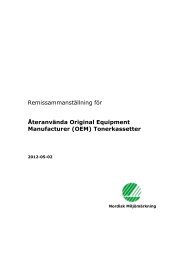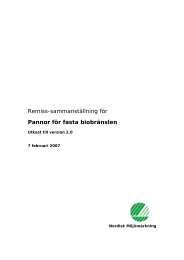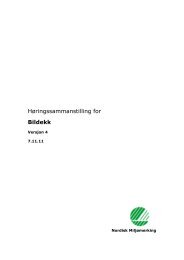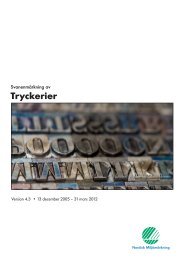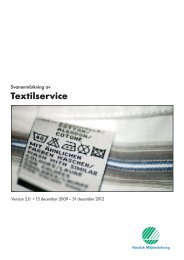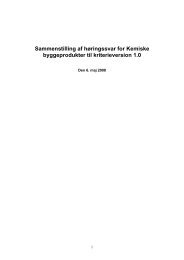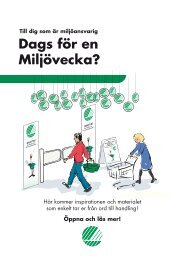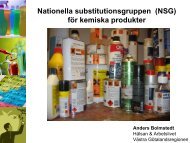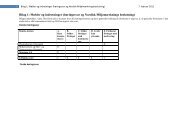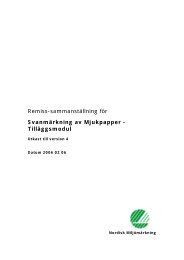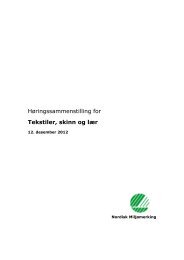Småhus, flerbostadshus och förskolebyggnader - Svanen
Småhus, flerbostadshus och förskolebyggnader - Svanen
Småhus, flerbostadshus och förskolebyggnader - Svanen
You also want an ePaper? Increase the reach of your titles
YUMPU automatically turns print PDFs into web optimized ePapers that Google loves.
Nordisk Miljømerking<br />
Hus, leiligheter og barnehager 089/versjon 2<br />
Høringssammenstilling, oppdatert 10. august 2010<br />
Boverket Sverige<br />
Boverket noterar att <strong>Svanen</strong>märkningen går längre än byggreglerna för endast några<br />
områden som finns för energieffektivitet i byggreglerna. Andra områden berörs inte.<br />
National Consumer Research Centre, Eila Kilpiö Finland<br />
We support the proposal, but suggest that in the newt revisions of the criteria, even more<br />
attention should be paid to primary energy consumption, the role of hot water and the<br />
provision of instructions to residents and other users of the buildings, as detailed below.<br />
The criteria stress energy efficiency and the type of materials used. As concerns energy<br />
efficiency, requirements are placed on airtightness and total energy consumption. Of<br />
these, we consider total energy consumption to be the more important criterion. It is also<br />
commendable that the criteria for energy consumption are in line with the calculation<br />
rules of the energy certificate for buildings. It is to be expected that the energy certificate<br />
criteria in Finland are to be revised in 2012 so as to take into account primary<br />
consumption, which will make the criteria more relevant than present.<br />
Ground source heat a good solution to decrease primary energy consumption and carbon<br />
dioxide emissions, in particular in buildings that are located outside the district heating<br />
network. We suggest that Nordic Ecolabelling develop labelling criteria for ground<br />
source heating system to complement the labelling criteria for housing.<br />
The relative significance of water heating grows when the airtightness and energy<br />
efficiency of the building structures increases. The water heating system becomes an<br />
important environmental criterion, in particular in buildings that are located outside the<br />
district heating networks. The proposed labelling criteria for houses deal with water<br />
heating in two ways: (1) water conserving fitting are a requirement and (2) points are<br />
awarded for solar water heaters. In future –as airtightness, etc. improve- increasing<br />
attentions should be paid to water heating utilising renewable energy in cases where the<br />
buildings are located outside the district heating system. Solar water heaters are already<br />
legally mandated in a number of European countries and cities.<br />
The building users have a significant impact on the energy consumption of the building.<br />
In the future criteria revisions, increasing attention should be paid to providing all users<br />
with instructions on how to use the building energy efficiently. The current labelling<br />
criteria proposal focuses on maintenance manuals; however these are not necessarily<br />
communicated to residents in multi-apartment buildings or to day-care centre staff. The<br />
information for users should clearly communicate that Swan-labelled buildings do not<br />
conserve the environment unless they are used in an environmentally sound way.<br />
Nordisk Miljømerkings kommentar<br />
Considering primary energy factors and estimating energy sources were not an issue for<br />
this version of the criteria, but your comments are of value and will be taking into<br />
consideration for the next revision of the document. The Swan label already has criteria<br />
for heat pumps that includes ground-source heating system.<br />
31 (165)



